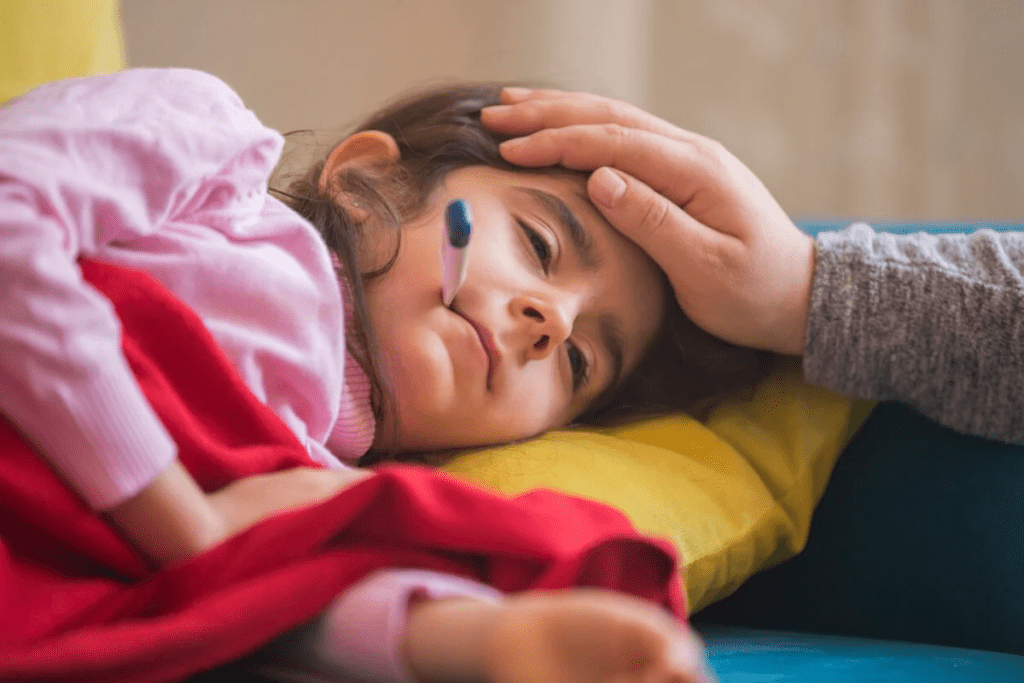Last Updated on November 14, 2025 by
Understand fever duration in toddlers and discover effective ways to manage and reduce fever quickly.
A toddler’s fever is a common worry for parents. Knowing how long it lasts and why is key to your child’s health.
A pediatric expert says a fever from a virus can last 24 hours to three to four days. A fever in a toddler is when their body temperature goes over 38 °C (100.4 °F).

Most fevers in kids come from viruses and usually last 2 to 3 days. At LivHospital, we focus on the latest, best treatments for kids with fever. We aim to keep your child healthy and comfortable.
When your toddler has a fever, it’s normal to worry. But knowing what a fever is and why it happens can help. A fever is when your body’s temperature goes over 100.4 ° F. It means your body is fighting off an illness.

In toddlers, a fever is when their temperature goes over 100.4 ° F. It’s important to know that teething does not cause fever. If your child has a fever, it usually means they have an infection. Use a digital thermometer to check their temperature.
Fevers in young children often come from viruses or bacteria. The flu, ear infections, and stomach bugs are common causes. Knowing why your child has a fever helps you manage it better and decide when to see a doctor.
Toddlers and adults handle fevers differently. Toddlers can get a fever fast, unlike adults, who might feel it rising slowly. A fever can also affect a toddler’s mood and energy levels. Some might stay active, while others might feel tired or cranky. It’s important to understand these differences to care for your child properly.
About 15“25% of kids’ doctor visits are for fever. Most of these cases are mild and get better on their own. Knowing the causes and symptoms helps parents handle these situations better.
Toddler fevers can be scary, but knowing how long they last helps parents manage them. Fevers are common in young kids and usually aren’t a big worry.

Most fevers in toddlers last 2 to 3 days, thanks to viral infections. During this time, their temperature might go up to 102 °F or 103 °F. It’s important for parents to watch their child’s temperature and make sure they drink plenty of water.
Research shows that only a small percentage of fevers in doctors’ offices are serious. This number can go up to 25% in emergency rooms. Knowing this helps parents understand how serious their child’s fever is.
The type of infection can tell you how long a fever will last. Viral fevers usually get better on their own in a few days. On the other hand, bacterial infections can cause fevers that last longer and might need antibiotics.
For example, fevers from viral illnesses usually stay between 101 °F and 104 °F for 2 or 3 days. If a fever goes above 104 °F, it’s a sign of a serious infection and needs immediate doctor’s care.
Several things can make a toddler’s fever last longer. These include the cause of the fever, the child’s health, and any complications. For example, if a toddler has a health problem, their fever might stick around longer.
By knowing these factors, parents can better handle their child’s fever and know when to get medical help.
A feverish toddler can be upsetting. But there are steps you can take to help manage their temperature and comfort at home. You can use medication, comfort measures, and make sure they stay hydrated and rest well.
For fevers over 102 °F, fever medication is often needed. Acetaminophen and ibuprofen are good choices for toddlers. But it’s important to follow the dosage instructions based on your child’s age and weight. Always check with your pediatrician if you’re unsure about the right medication or dosage.
When giving fever medication, watch your child’s temperature closely. Adjust the dosage as needed. Keep track of when you give each dose to avoid giving too much.
There are comfort measures you can use, too. Dress yourself in light clothes and keep the room at a comfortable temperature. A lukewarm bath can be soothing, but avoid cold water as it can make your child shiver and raise their temperature.
Hydration is key when your child has a fever. Encourage them to drink lots of fluids like water, clear broths, or Pedialyte. For breastfed babies, keep breastfeeding as usual.
It’s also important to make sure your child gets plenty of rest. Fevers can be tiring, so let them rest as much as they need. A calm, quiet place can help them sleep better.
By using safe medication, comfort measures, and focusing on hydration and rest, you can help your toddler feel better. If you’re unsure about your child’s fever or how to manage it, always talk to your healthcare provider.
A fever can worry parents a lot. It’s important to know when to see a doctor. Fevers are common in toddlers, but some cases need a doctor’s visit.
Infants under 12 weeks old need quick medical help for fevers. Babies under 6 weeks old with a fever should go to the emergency room. For older babies, talk to your pediatrician.
Key age-based guidelines include:
Some symptoms with a fever are warning signs. These include:
If a toddler shows these symptoms, get medical help right away.
Some cases need immediate medical care. If a toddler’s fever comes with:
Understanding and managing toddler fevers is key to effective care and easing parental worries. Knowing the causes, symptoms, and how long fevers last helps parents support their child better.
LivHospital is dedicated to leading-edge, evidence-based care for kids. This means parents get the help they need to handle fever episodes confidently. LivHospital’s focus on teamwork helps families get better support for childhood fevers.
Being informed and ready helps parents calm their nerves and care for their child well. To support your child through fever episodes, you need knowledge, patience, and quality healthcare. LivHospital offers just that.
A fever in toddlers is when their body temperature goes over 38 °C (100.4 °F).
Most fevers in kids come from viruses. They usually last 2 to 3 days.
Viral infections often cause fevers in young kids. Bacterial infections, teething, and other factors can also trigger them.
To manage your toddler’s fever at home, use safe medicines. Provide comfort, make sure they drink water, and help them rest.
Always talk to a doctor before giving your toddler medicine. Acetaminophen or ibuprofen is safe when used correctly.
See a doctor if your toddler is under 3 months, seems distressed, has a fever over 40 °C (104 °F), or shows other concerning signs.
Look out for signs like trouble breathing, severe headaches, stiff neck, or a rash. These could mean a serious issue.
A low-grade fever is when a child’s body temperature is between 38 °C (100.4 °F) and 39 °C (102.2 °F).
Symptoms for bacterial and viral infections can be similar. A doctor might need to do tests to find out the cause.
A high fever in toddlers is when their body temperature goes over 40 °C (104 °F).
Kool, M., Elshout, G., Moll, H. A., Koes, B. W., van der Wouden, J. C., & Berger, M. Y. (2013). Duration of fever and course of symptoms in young febrile children presenting with uncomplicated illness. Journal of the American Board of Family Medicine, 26(4), 445-452. https://pubmed.ncbi.nlm.nih.gov/23833160/Health Matters. (2025, August 8). Fever in children: What to know and when to worry. NewYork-Presbyterian. https://healthmatters.nyp.org/fever-in-children-what-to-know-and-when-to-worry/British Medical Journal Best Practice. (2025, July 29). Assessment of fever in children – Differential diagnosis and management. https://bestpractice.bmj.com/topics/en-gb/692
Subscribe to our e-newsletter to stay informed about the latest innovations in the world of health and exclusive offers!